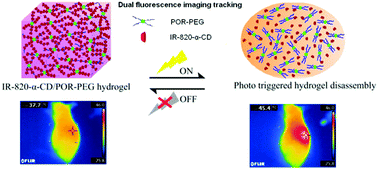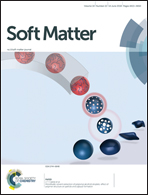Photothermally triggered disassembly of a visible dual fluorescent poly(ethylene glycol)/α-cyclodextrin hydrogel
Abstract
The real-time tracking and adjustment of the disassembly and status of hydrogels in vivo are important challenges to accurate and precise assessment. In this article, a photothermally controllable, visible, dual fluorescent thermosensitive hydrogel was designed and developed based on a porphyrin–poly(ethylene glycol)/IR-820–α-cyclodextrin hydrogel. Due to the photothermal effect and fluorescence emission of IR-820, it can exert the dual functions of photothermal control and fluorescence imaging tracking. The IR-820 conjugated hydrogel can regulate the hydrogel disassembly by the photothermal effect of IR-820. Furthermore, each component of the hydrogel can be tracked by the fluorescence of IR-820 and porphyrin. Fluorescence imaging tracking and remote photothermal control were merged into the visible and controlled hydrogel disassembly after subcutaneous injection using mice as models. The dual fluorescence imaging visualization of cyclodextrin/poly(ethylene glycol) hydrogels revealed the disassembly process by tracking each component, and the hydrogel disassembly can be efficiently accelerated under laser irradiation with the photothermal effect of IR-820. This affords an important basis for understanding the disassembly process of the poly(ethylene glycol)/α-cyclodextrin hydrogel.



 Please wait while we load your content...
Please wait while we load your content...